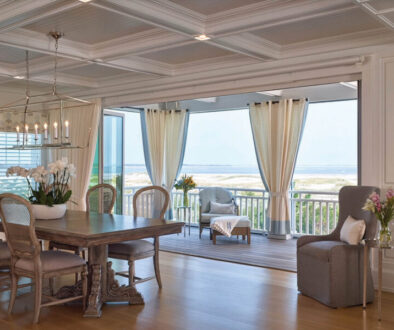City Hall

634 Washington St
In the High Summer issue of this magazine published last month, this column examined the composition of Block 1059, between Ocean and Franklin Streets, focusing on the architectural relic that is the Memucan Hughes House (otherwise known as the Colonial House Museum). Another historic structure that has stood the test of time, just next door to the Colonial House, is Cape May City Hall—formerly Cape May High School. Designated as a “key contributing” building by the Cape May City Historic Preservation Commission, it’s considered to be a structure that should not be significantly altered. Now more than 100 years old, the building was constructed in 1917, in coordination with plans designed by Mays Landing native and Atlantic City architect S. Hudson Vaughn. When it was completed and the halls were filled with students, the institutional structure became the second iteration of Cape May High School—the original, nearby on Lafayette, was converted to an elementary school. Decades later, in 1961, Cape May High School closed and the building was converted to serve as City Hall.
The building is two stories and includes a basement level. It is rectangular in plan, with a double-loaded corridor (rooms on both sides) running front to back. The symmetry in plan is congruently reflected on the exterior of the building. Originally, the corridor was only intersected by the centrally located auditorium. The auditorium itself is a double-height space, reaching the underside of the roof. What were designed as mirrored classrooms now serve as municipal offices toward the front of the building. Conversely, as the corridor stretches toward the rear of the building, the interior has been modified significantly to accommodate police station and municipal court functions. The spaces on the basement level have been altered to fit other offices, including construction and zoning. The auditorium continues to host large groups of people; however, today those events are mostly meetings of city council and the various advisory/regulatory boards, as opposed to assemblies of the student body.
The design of the building exterior, in this case the Beaux Arts style, is indicative of the widespread prominence of public buildings erected throughout America at the onset of the 21st century. Its brick construction is certainly the most notable feature of the former high school, given the architectural fabric of Cape May, which is predominantly composed of wood frame construction. Another example of a distinguished civic structure built with brick is the Franklin Street School, less than 100 feet away, around the corner on the same block. As this column is written, the new firehouse is being constructed between the two historic school buildings and has been designed to integrate well with similar cladding, creating a small cluster of brick buildings on Block 1059.
City Hall’s symmetrical south-facing façade, fronting on Washington Street, evokes a sense of order. Its exterior walls feature brickwork that is primarily arranged in a Flemish bond, over a limestone watercourse that caps the poured concrete foundation wall. A row of four limestone diamond motifs is positioned at the floor level between each of the first- and second-floor window openings. Those openings accommodate four twelve-over-one, double-hung windows, which have replaced the originals. Over the second-floor windows, a molded wood cornice wraps around the entirety of the building. Above that, a brick parapet wall also encompasses the building perimeter, the front of which is still adorned with “Cape May High School” engraved in a slab of limestone at the center, positioned between scrollwork carved from the same material.

Just around each front corner, on both the east and west façades, a rectangular patterned relief in the exterior brick wall stretches two stories. Its inside and outside corners are marked with limestone blocks of two different sizes. Beyond that, another stacked bank of four windows, similar to those on the front—though some have seemingly been infilled with matching brick. On the east elevation, there are two identical side entrances to stairwells that flank the auditorium volume, which now serve as separate points of access to the municipal administrative spaces and police/court spaces, respectively. With the law enforcement offices situated toward the north end of the building, it may seem to make sense that the rear elevation has very few windows. However, this was likely by design when originally planned, as the north side of the building receives little sunlight and takes the brunt of prevailing winds. In fact, the back of the building only has one window opening at each floor level and unlike the other sides of the building foundation, it has no basement windows.
While the former Cape May High School has adapted to function as Cape May City Hall for more than 60 years, it’s difficult to argue the building doesn’t have shortcomings in its current use(s). It’s impractical to imagine that it can continue serving its various purposes for years to come—and it’s unlikely. Since the public discourse began to consider the idea of a new public safety building, and the completion of a new firehouse is imminent, it’s fair to assume the police will relocate to a new station in the somewhat near future. If that were to happen, it may alleviate some space constraints for the other departments. That said, it’s still unclear if the city plans to continue its long-term occupation of the 1917 high school building as a catchall building for administrative functions. If not, what might the building’s future hold?
Regardless, it is important to ensure that the building is preserved and celebrated for its good design, as it has been. City Hall is a pristine example of the impressive civic architecture developed in the United States at the turn of the century. As discussed, it is one of very few historic brick buildings remaining in town—among the Franklin Street School (opened in 1928), the post office (completed in 1938), Winterwood (originally constructed as a bank in 1897), the former Stewart’s Root Beer, now Free People (first constructed as a bank in 1928), and Congress Hall (c. 1879). In a city renowned for its abundance of Victorian architecture, highlighting the best samples of other architectural styles is worthwhile.
We should continue to preserve the historic integrity of these most notable buildings. Though, it is also important that we don’t impose such constraints on the redevelopment of historic structures that may prevent increased efficiency, whether that be in terms of how a building is occupied or how a building is operated. Currently, City Hall is undergoing a project to install solar panels on its roof. In the historic district, which encompasses about half the town, solar panels are a touchy subject. Certainly, they didn’t exist in the time when much of Cape May was built. These ultramodern materials are often seen as hideously foreign when mounted to the pitched roof of a 19th-century residence. However, solar panels on City Hall’s roof are viewed as having less of an impact on the historic streetscape, as they will be mounted on a flat roof behind a parapet wall and generally out of sight.
Nevertheless, there should always be a way to balance the desired preservation of historic structures with the modernization required to safeguard their longevity. City Hall’s solar project is a good example of finding the right solution. Although one site-specific example, it indicates the possibility of employing alterations to other significant buildings throughout town without compromising those buildings’ historic integrity. This has become and will remain an ongoing conversation as we witness the continued redevelopment in Cape May. Like City Hall, the former high school, the use of other buildings in town is sure to change. How we allow them to change is to be determined. ■



